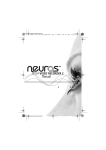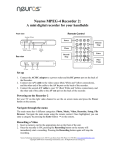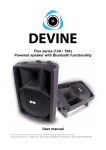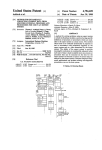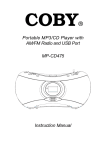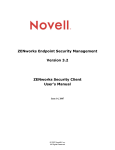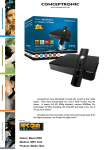Download Neuros Audio OSD 6011000 User's Manual
Transcript
Charging/Docking Station - The OSD will charge most USB devices that are plugged into it, so you can use it as a docking station for your iPod™ and other portables even while recording to or playing back from them. Abbreviated Users Guide Thank you for purchasing a Neuros OSD, the device that lets you digitally store and easily access your DVD’s, VHS tapes, home movies, and TV shows. Part 1 - Overview Purpose of this Abbreviated User’s Guide This Abbreviated User’s Guide is provided to: (i) give you a brief overview of the OSD and its capabilities; (ii) show you how to connect your OSD; and (iii) teach you a few basics of how the on-screen menu system works on your OSD. Once you have your OSD connected and know these basics, the OSD’s on-screen menu system should guide you through everything else you may need or want to know. Free Firmware Upgrades Your Neuros OSD already does everything it was advertised to do – and more – but we’re not stopping there. With the help of our rapidly growing worldwide community of users and open source developers, we will continually update the OSD with exciting new features and applications. We make these new capabilities available to you via regular “firmware” upgrades (Note: firmware is just a fancy name for the software that is loaded onto the OSD). These upgrades are free and can be done in minutes by users of any level (see Part 6 – Upgrading the OSD Firmware). Sharing - The OSD has features to make it easy for you to share non-copyrighted content from the comfort of your living room. Look for more features to be added over time (Note: may require a firmware upgrade). CF Card.Microdrive SD.MS.MMC USB [host] Serial Svideo IN IR Out A/V In/Out Menu Navigation Contextural Help Display toggle on/off Numeric keyboard Back/Exit TV Volume /Mute NTSC/PAL The OSD remote control contains specialized keys configured for controlling the on screen menu system User’s Manual The OSD, itself, should guide you through what you’ll want to do. However, a more detailed User’s Manual with FAQ’s is available at: http://www.neurostechnology.com/support The User’s Manual is updated with each new firmware version, so be sure to use the User’s Manual corresponding to your firmware version. If for some reason you choose not to keep your firmware upgraded to the latest version, archived copies of older firmware versions are available as well. LAN Power Media playback TV Channel TV Input TV power Xtra Options Menu Enter/select One Touch Recording Home menu Main Functions Video Recorder - Record video in standard MPEG-4 formats from any device with standard (i.e. not High Definition) video outputs such as DVD players, Satellite receivers, Cable boxes, VCRs, DVRs, etc. to virtually any USB storage device (external hard drives, iPod™, PSP™, etc), any major memory card (SD, MMC, Memory Stick; Compact Flash, microdrive), or directly to your computer or network attached storage. Included accessories Two RCA Composite A/V cables (red, white and yellow plugs) Universal power supply (110 to 240 V) IR blaster Stand IR remote (two AAA batteries included) Video Player - Play recorded, downloaded, and streamed video (including YouTube) on your TV from USB storage devices, memory cards, computer/home network, and the Internet. Note: some versions may also include a serial cable. If yours does not, and you are a developer and want one, please visit http://www.neurostechnology.com/support to request one. Music/Audio Player - Play music, podcasts, and other audio files directly on your stereo from your from memory cards, USB devices (MP3 players, external hard drives, etc), computer/home network, and the Internet. Note Also: some non-U.S. versions may also have RCA-to-SCART adaptors. Photo/Image Viewer - View photos and other images on your TV from USB devices (external hard drives, digital cameras, etc), memory cards, computer/home network, and the Internet (Note: Internet photo viewing may require a firmware upgrade). Audio Recorder - Record audio in standard MP3 and AAC formats from any audio source to any major memory card (SD, MMC, Memory Stick; CF, microdrive), virtually any USB storage device (iPod™, external hard drives, PSP™, etc), or directly to your computer/home network (Note: may require firmware upgrade). Part 2 – Connecting the OSD If you can set up a VCR, you can set up a Neuros OSD. In fact, the set-up is so easy and the OSD is so compact you can take it with you on trips or to a friend’s house if you want…. On the other hand, the OSD looks great as a part of your entertainment center, is silent, has no moving parts, and automatically passes through any audio or video input signal to your TV when it’s not in use recording or playing anything or being accessed with the remote, without any signal degradation. The OSD is turned off by unplugging it (there is no “Off” button), but, since it consumes virtually no power in pass-through mode, there is never any reason to unplug your OSD unless you want to take it with you. 1 2 2A. Connecting to Power 1. Connect the included power supply to the wall. Note: S-Video cable not included. 2. Plug the other end into the 5V power input jack on the right side of the OSD. 3. The dim green light on the top/left side of the OSD should turn on. The OSD power supply is universal (this means it will work with any voltage between 110V and 240V). 2. Connect the RCA composite cable ends to the corresponding A/V OUT plugs of your video source (Yellow=Video, Red=Audio Right, White=Audio Left). Note: If using the S-Video cable, you will still need to connect the Red and White RCA plugs (for audio), but not the Yellow one (which is replaced by the S-Video cable). Note: Power plug adapters may be required for use in countries outside of the intended one and are not included. 2B. Connecting to TV You control the OSD using the included remote control and an on-screen menu that the OSD displays on your TV. Connecting the OSD to the TV allows you to see the on-screen menu and also allows you to playback video on your TV. 1. Connect one of the included RCA Composite A/V cables to the A/V OUT port on the right side of your OSD. Any Video Source 2D. Inserting Memory Cards or Connecting USB storage devices (optional) This step is required if you want to directly record to or playback files from memory cards or USB storage devices. It is not required to access the Internet or to directly record to or playback from your networked computer. TV CF/Microdrive Slot R Audio IN L Video IN 2. Connect the RCA composite cable ends to the corresponding inputs on your TV A/V IN plugs (Yellow=Video, Red=Audio Right, White=Audio Left) 3. Tune your TV to the proper channel for the inputs you just plugged your A/V cable into, just like hooking up a VCR or DVD player to your TV (ex: Input or Video 1, Input or Video 2, Channel 3, Channel 4... or just change the channel on your TV until you see the OSD menu). 4. You should see the Neuros OSD startup screen on your TV. This slot will accept Compact Flash cards and Microdrives. Insert as shown on right. SD/MS/MMC slot This slot will accept Secure Digital, MS Duo / MS Pro Duo and Multimedia Cards. Insert as shown on left. In addition to the standard size cards, you will also be able to use MiniSD, Micro SD, MMC Mobile and RS-MMC type cards with the proper adapter. A sampling of the many storage options are below. Press the home button if you don’t see anything on the TV screen as doing so will always bring up the Main Menu of the OSD. Note: The Audio cables (Red/White) can be connected to your stereo receiver instead of your TV if you want to play the audio through your stereo instead of through your TV. The Neuros OSD supports NTSC, PAL standards and SECAM video input. Pressing the NTSC/ PAL button on the remote will switch between NTSC and PAL. NTSC is used in the U.S. 2C. Connecting to Video Source (optional) This step is required if you want to record video from any of your various video sources (DVD player, VCR, Game Consoles, Camcorder, TiVo/DVR, camcorder, etc). It is not required if you only want to stream Internet content to your TV or playback content from memory cards, USB devices, or your computer. Note: Virtually all video sources have RCA composite output (Red, Yellow, and White plugs on the TV) while some video sources also allow the higher quality S-Video output to be used. 1. Connect one of the included RCA Composite A/V cables to the A/V IN port on the right side of your OSD. If using S-Video, connect both the S-Video and the RCA cables. 3 Abbreviated Guide.indd 1 4 9/13/07 11:19:05 PM USB Port The USB port on your OSD will allow you to read/write to/from many different USB devices, including external hard drives, iPod™s, USB thumbdrives, and other portable media players (including MP3 and MP4 players). External hard drives using the standard FAT32 file system are strongly recommended. Other formats may be supported now or in the future. See http://www.neurostechnology.com/support for details and updated information. Note: Almost any hard drive can be formatted to FAT32 (instructions are also at http:// ww.neurostechnology.com/support) and most are by default. If in doubt, you should consult the packaging or manual from the hard drive manufacturer for more information. 2E. Connecting the IR blaster (optional) This step is required only if you want to use your OSD to control other devices such as your cable or satellite box by emulating the remote control signals of these devices. The most common usage for the IR blaster is to change the channel on your cable or satellite tuner when doing scheduled TV recordings. This will allow the OSD to record from different TV channels at different times without you having to be there to manually change the channel. 1. Go to the Settings Menu from the Main Menu and select IR blaster. Follow the on-screen instructions to “teach” your OSD how to emulate the remote control of the other device. You will only need to do this once for each device. 2. When you are ready to use the IR Blaster (like when you’re going to do a timed recording and need the IR Blaster to change the tuner channel), place the bulb end of the IR blaster so that the bulb is looking directly into the IR window on the device you want to control and plug the other end into the IR Out port of the OSD. Remember, the bulb end of the IR blaster will act just like the IR bulb inside a remote control. It has to be pointing at the right place (the IR window) in order to work. You can semi-permanently affix the IR bulb to a table top by exposing the adhesive strip on the bottom of the base that holds the bulb. Note: The IR Blaster only works with IR remotes. It won’t work with UHF or other remotes. Note Also: The IR signal is invisible, so you won’t see the bulb light up when it is activated. 2F. Connecting to the Internet (optional) This step is required if you want to (i) stream content from the Internet; (ii) receive automatic firmware upgrades via the Internet (see Firmware Upgrades below); or (iii) upload or share content from the OSD via the Internet. It is not required if you only want to record to or playback from USB devices or memory cards. Note: Like a PC, the Neuros OSD can access the Internet by being connected to a standard Ethernet router using a standard Ethernet cable (CAT5). If you have a home network that can connect to the Internet already, you probably already have this equipment. For more information, please visit the website at http://www.neurostechnology.com/support. 1. Insert one end of a standard Ethernet cable (not included) into an output port on your router or hub and insert the other into the Ethernet port of the OSD. 2. From the on-screen Main Menu of the OSD, enter the Settings menu and then choose Network. Follow the instructions there for Connecting to the Internet. Note: The OSD can also be connected to the Internet wirelessly using a wireless bridge (not included). Details on how to connect wirelessly will also be provided under Settings > Network. Note: Since the Neuros OSD does not have a web browser, you will be able to access a few selected sites (YouTube initially and others that will be added in future firmware upgrades. 2G. Connecting to a Computer on a home network (optional) This step is required if you want to directly record to or playback files from your computer’s hard drive. It is not required to access the Internet or to record to or playback from memory cards or USB devices. Note: You cannot connect the OSD directly to your computer. You will need a standard Ethernet router to do this step. If you have a home network, you will probably already have this equipment. If you wish to connect the OSD wirelessly, you will also need a wireless bridge (not included). 1. Insert one end of a standard Ethernet cable (not included) into an output port on your router or hub and insert the other into the Ethernet port of the OSD. 2. From the on-screen Main Menu of the OSD, enter the Settings menu and then choose Network. Follow the instructions there for Connecting to the Network. 3. You may now record to and play back from other PCs on your home network. Note, however, that you may need to create a shared folder with Full Control permissions for everyone on your PC. Please refer to http://www.neurostechnology.com/support for updated support information. 2H. Connecting to Serial Port (optional) The serial port is primarily used for developers and advanced users. It will allow you to hook up your OSD to a PC monitor and some types of tuners. 1. Plug single-pin end of included serial cable into the OSD. Plug the multi-pin end into the PC monitor or other device. Part 3 Introduction to the OSD Menus Menus and Navigation 1. A set-up screen may appear the first time you connect and turn on your OSD. If so, follow the instructions on this screen. 2. If there is no initial set-up screen, the Main Menu will appear on the OSD. From within the Main Menu, highlight the Getting Started option on the Main Menu (by scrolling to & DOWN keys on the remote), then Press Enter or it with the UP Right Arrow to select it. Note: If the Main Menu doesn’t appear on-screen, press the Home button remote to bring it up or to return to it at any time. on the Note Also: When no buttons are pressed for a period of time, the menu will disappear and show only the source video, if any, on the screen. 3. Read the instructions in the Getting Started menu to learn how to perform various tasks. 4 Hit Back Arrow to return to the previous menu. What if You Get Lost of Don’t Know What to Do? Help is Always Just a Click Away. If you want to know what a menu item does or how it works, simply highlight it by browsing to it, then press the Help button on the remote. This will bring up a help screen that is specific to the highlighted menu item. Button (Options). Whenever the is visible on the right When in Doubt, Hit the side of a given menu selection, you can press the button on the remote for additional options or information. The options available are specific to the location within the menu when button is pressed. You will want to experiment with this and use it often because many cool and often essential features are contained within the options menus. 5 Part 4 – Choosing the Right Recording Settings for You One of the most important uses of the OSD is in recording from virtually any video source into variations of the popular MPEG-4 format (which is to video what MP3 is to audio). Once in the MPEG-4 form, the video can be: safely stored and organized on hard drives, portables, or memory cards; easily accessed for playback on TVs and computers; edited; transferred to portables and other devices for playback on the go; easily shared with others (non-copyrighted video only!); and so on. There is one subtlety, though: some portable devices are compatible with only lower resolution and/or lower quality files, which look great on the small screens of portables but may not look as good on a TV. Files recorded at the highest resolution and quality levels will look best on the TV but may not be compatible with smartphones and other portable devices. When you make a recording, you can choose the device or devices you plan to use to play back the recorded file. Your choice here will optimize the resolution for that particular device, but will not necessarily mean you will not be able to play back your files on your other devices. For example, choosing a setting that optimizes the recording for playback on larger screens like TV’s and PC’s will create larger data files and may make the files unwatchable on some handhelds. If you care more about having high quality recordings for playback on larger screens than you do about compatibility with a range of handhelds and have plenty of available storage space, you may want to choose this setting. On the other hand, choosing a setting that optimizes the recording for playback on a handheld like a smartphone will create smaller data files that will be playable on just about any device (including the TV), but the quality of these files won’t look as good on a TV or other device with a larger screen. If you want to ensure file compatibility with the greatest number of devices, want to conserve disc space, and/or don’t mind a lower quality picture on larger screens, these settings are for you. For more detailed information, scroll to highlight “Record” on the Main Menu, then press the Help (?) button or go to http://www.neurostechnology.com/neuros-osd-recordingsettings. Part 5 – Assigning Permanent Storage (optional) This step is done to effectively extend the internal memory of the OSD and will only be necessary if: (i) you want to use database features for organizing and accessing your music content (activities like searching by artist, album, etc), which will be available in firmware versions released in October, 2007 or later; or (ii) you want to take advantage of applications that may be made available in future firmware upgrades that exceed the available internal memory of the OSD. Any such applications would be optional. Step 1 From the Main Menu, go to Settings > Permanent Storage and follow the instructions there. Part 6 – Upgrading the OSD Firmware (Optional) See Part 1 - Overview above for an explanation of why you may want to do this from time to time to take advantage of cool new features that will be added free of charge to the OSD. These upgrades can be done either manually or automatically. Manual Firmware Upgrades (use this method if not connected to Internet) 1. Using your computer browser, go to: http://www.neurostechnology.com/upgradeneuros-osd 6 3. Once download is complete, plug the memory card or USB storage device into your OSD. 4. Select Play/Browse from the OSD Main Menu, browse to the downloaded firmware file (it will have a .upk extension), and press Enter . Then select OK to begin the installation. Or: Automatic Firmware Upgrades (recommended if connected to Internet) 1. Make sure your Neuros OSD is turned on and connected to the Internet (see Parts 2.A and 2F above). 2. Go to Settings > Firmware Upgrade and change Frequency from Off to Daily or Weekly, depending on how often you want the OSD to check for new firmware upgrades. Then set Select Update Type to Official (recommended for mainstream users), Beta (recommended for users who want the latest firmware but don’t mind a few bugs as these releases haven’t been as thoroughly tested as the Official releases) or Dev (recommended for developers who want very regular releases and don’t mind that these releases have not yet been tested by Neuros or the Neuros community). Set Time H:M to the time of day you want the OSD to look for upgrades (in hours and minutes). 3. Go to Check Now and hit Enter to immediately look for new upgrades. If newer firmware is available, the Neuros OSD will download and immediately begin installing it. Once the install is complete, the OSD will automatically re-boot with the new firmware installed. Part 7 – Troubleshooting the OSD If you get lost of don’t know what to do, hit the Help or button (see Part 3 above). If your OSD appears unresponsive to the remote or otherwise appears to lock up, first make sure the remote is within range and pointing at the OSD’s IR window (located on left side of the OSD just to the right of the CF/microdrive slot). If that doesn’t work, try simply waiting for a minute or two. The OSD will often work the problem out by itself. If the unresponsiveness persists, re-boot the OSD by unplugging and re-plugging the power supply (see Part 2A above). You might also try checking or replacing the batteries in the remote. If problems persist, go to http://www.neurostechnology.com/support for a complete User’s Manual, up-to-date FAQ’s, forums, and contact information for Neuros customer support. Part 8 – Your Feedback is Essential Perhaps more than any consumer electronics company in history, we rely on our users of all types to help us make our products the best in the world at what they do. If you find something confusing, missing, exciting, or some other adjective, please let us know by going to http://www.neurostechnology.com/feedback. This isn’t just an opportunity to vent. While we have to prioritize and balance the needs of all our users and can’t promise anything, there’s a real chance your insights will show up in a FAQ, in upgraded instructions on our web site, or even in a future firmware release. It happens all the time. Part 9 – Calling all Developers The Neuros OSD is a collaborative effort between our dedicated full-time internal developers and our open source community. There are three main areas where our developer community contributes: documentation, implementation, and testing, all defined broadly. If you’re a developer and want to learn more, please go to: http://www.neurostechnology.com/neuros-developer-community 2. Download the latest firmware for the OSD to a memory card or USB storage device. 7 Abbreviated Guide.indd 2 8 9/13/07 11:19:09 PM


